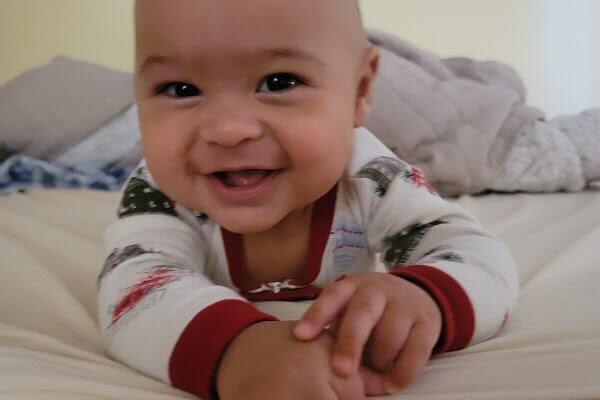Courtesy of the March of Dimes
During the first year of life, your baby will grow and develop at an amazing speed. Her weight will double by 5 to 6 months, and triple by her first birthday. And she is constantly learning. Major achievements—called developmental milestones—include rolling over, sitting up, standing and possibly walking. And your heart will likely melt at the sound of her first “mama” or “dada.”
No two babies are exactly alike. Your baby will develop at her own pace. Most babies reach certain milestones at similar ages. However, it’s not unusual for a healthy, “normal” baby to fall behind in some areas or race ahead in others.
The following milestones are only guidelines. Your baby’s health care provider will evaluate your baby’s development at each well-baby visit. Remember: Always talk to your child’s health care professional if you think your baby is lagging behind.
If your baby was born prematurely (before 37 weeks of pregnancy), you need to look at the milestone guidelines a little differently. The age at which your baby is expected to reach various milestones is based on her due date, not her birthday. So if your baby was born two months early, she will most likely achieve milestones two months later than the guidelines below predict.
By the end of their first month, most babies:
- Make jerky, quivering arm movements
- Bring hands near face
- Keep hands in tight fists
- Move head from side to side while lying on stomach
- Focus on objects 8 to 12 inches away
- Prefer human faces over other shapes
- Prefer black-and-white or high-contrast patterns
- Hear very well
- Recognize some sounds, including parents’ voices
For an interactive guide to newborn behavior, go to Understanding Your Newborn.
By the end of their third month, most babies:
- Raise head and chest when lying on stomach
- Support upper body with arms when lying on stomach
- Stretch legs out and kick when lying on stomach or back
- Push down on legs when feet are placed on a firm surface
- Open and shut hands
- Bring hands to mouth
- Grab and shake hand toys
- Follow moving object with eyes
- Watch faces closely
- Recognize familiar objects and people at a distance
- Start using hands and eyes in coordination
- Begin to babble and to imitate some sounds
- Smile at the sound of parents’ voices
- Enjoy playing with other people
- May cry when playing stops
By the end of their seventh month, most babies:
- Roll over both ways (stomach to back and back to stomach)
- Sit up
- Reach for object with hand
- Transfer objects from one hand to the other
- Support whole weight on legs when held upright
- Develop full-color vision and mature distance vision
- Use voice to express joy and displeasure
- Respond to own name
- Babble chains of consonants (ba-ba-ba-ba)
- Distinguish emotions by tone of voice
- Explore objects with hands and mouth
- Struggle to get objects that are out of reach
- Enjoy playing peek-a-boo
- Show an interest in mirror images
By their first birthday, most babies:
- Sit without assistance
- Get into hands-and-knees position
- Crawl
- Pull self up to stand
- Walk holding onto furniture, and possibly a few steps without support
- Use pincer grasp (thumb and forefinger)
- Say “dada” and “mama”
- Use exclamations, such as “oh-oh!”
- Try to imitate words
- Respond to “no” and simple verbal requests
- Use simple gestures, such as shaking head “no” and waving bye-bye
- Explore objects in many ways (shaking, banging, throwing, dropping)
- Begin to use objects correctly (drinking from cup, brushing hair)
- Find hidden objects easily
- Look at correct picture when an image is named
By their second birthday, most children:
- Walk alone
- Pull toys behind them while walking
- Carry large toy or several toys while walking
- Begin to run
- Kick a ball
- Climb on and off furniture without help
- Walk up and down stairs while holding on to support
- Scribble with crayon
- Build tower of four blocks or more
- Recognize names of familiar people, objects and body parts
- Say several single words (by 15 to 18 months)
- Use simple phrases (by 18 to 24 months)
- Use two- to four-word sentences (“want snack”)
- Follow simple instructions
- Begin to sort objects by shapes and colors
- Begin to play make-believe
- Imitate behavior of others
- Show growing independence
For more information, view the video Baby Steps: Learn the Signs from the Centers for Disease Control and Prevention.
Source: American Academy of Pediatrics. “Caring for Your Baby and Young Child: Birth to Age 5, Fourth Edition” (Bantam Books, 2005).
What your baby should be doing, and when.



